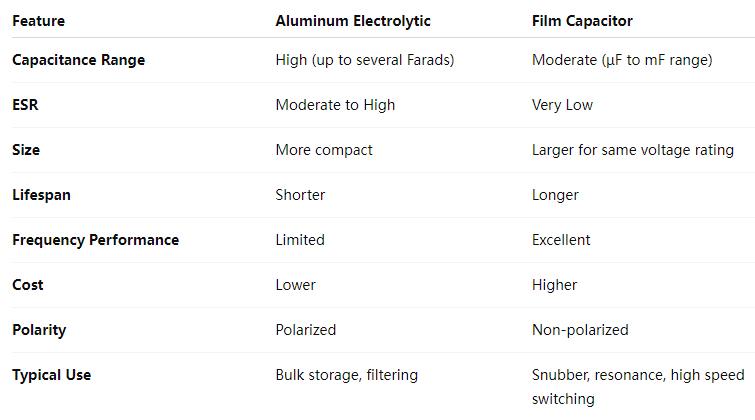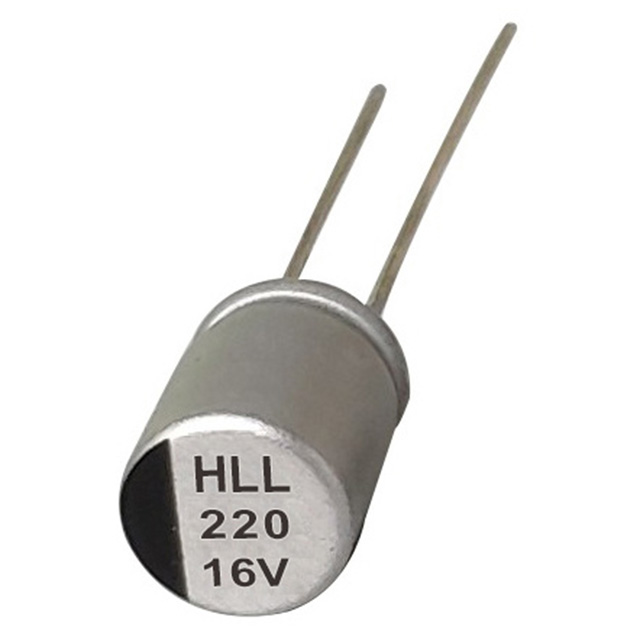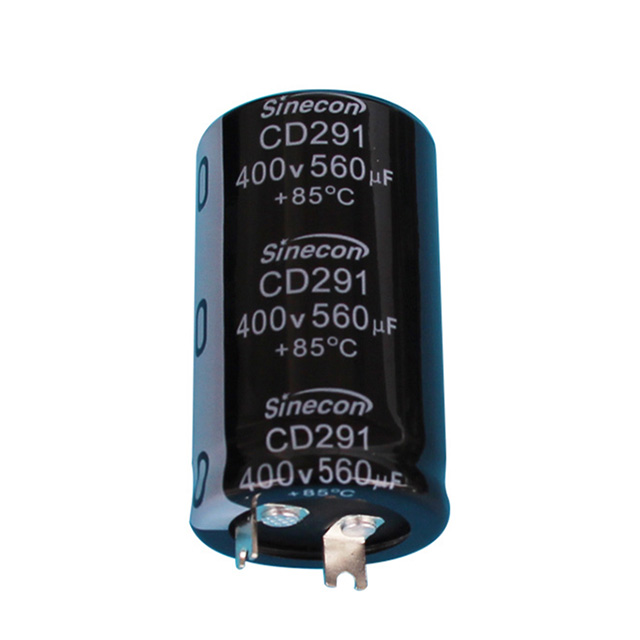1.Introduction to Screw Terminal Capacitors
Capacitors are fundamental components in electrical and electronic systems, designed to store and release electrical energy as needed. They are used in a wide range of applications—from filtering noise in audio circuits to stabilizing voltage in power supplies. By temporarily holding electrical charge, capacitors help smooth out fluctuations, improve power factor, and ensure reliable operation of sensitive components.
Among the various types of capacitors available, screw terminal capacitors stand out for their high performance in demanding applications. These capacitors are designed with threaded terminals, allowing them to be securely fastened with screws or bolts. This robust connection method enables them to handle higher current levels and operate more reliably in harsh environments compared to other types like radial or snap-in capacitors.
What makes screw terminal capacitors unique is not only their electrical performance but also their mechanical durability. Their design ensures strong and stable connections, which is critical in industrial and high-power systems where vibrations, temperature changes, and high currents are common.
Advantages of Using Screw Terminal Capacitors
High Current Handling: The screw terminal design allows for larger conductor sizes and lower contact resistance, making these capacitors well-suited for applications with high ripple current and large energy storage needs.
Secure Mechanical Connections: Unlike push-fit or soldered terminals, screw terminals provide a more secure and vibration-resistant connection, reducing the risk of electrical failure.
Ease of Installation and Maintenance: These capacitors are easy to replace in the field, making them a preferred choice for systems where downtime must be minimized.
Support for Larger Capacitance and Voltage Ratings: Screw terminal capacitors are typically used in applications requiring high capacitance values and voltage ratings, often ranging from hundreds to thousands of microfarads and up to several hundred volts.
Because of these advantages, screw terminal capacitors are widely used in industrial power supplies, inverters, uninterruptible power supplies (UPS), and many other high-power electronics applications. Their reliability, ease of use, and performance under stress make them indispensable in modern electrical engineering.
2.Types of Screw Terminal Capacitors
Screw terminal capacitors come in various types, each tailored to specific electrical and mechanical demands. The two most common types are aluminum electrolytic screw terminal capacitors and film screw terminal capacitors. Both are widely used in power electronics, but they differ significantly in construction, performance, and application suitability.
Aluminum Electrolytic Screw Terminal Capacitors
Construction and Characteristics
Aluminum electrolytic capacitors use an aluminum foil anode and cathode, separated by a liquid or solid electrolyte. The dielectric is formed by an oxide layer on the anode, and the electrolyte acts as the cathode’s conductive medium. The assembly is housed in a sealed aluminum can with screw terminals for electrical connection.
These capacitors are polarized, meaning they must be installed in the correct orientation with respect to polarity.
Advantages:
High capacitance values in a relatively compact size
Cost-effective solution for large energy storage
Good handling of high ripple current
Disadvantages:
Higher Equivalent Series Resistance (ESR) than film capacitors
Shorter lifespan, particularly at high temperatures or under continuous ripple stress
Limited frequency performance and stability
Typical Applications:
DC link capacitors in power inverters
Output filtering in switching power supplies
Bulk energy storage in industrial power systems
Film Screw Terminal Capacitors
Construction and Characteristics
Film capacitors use a thin plastic film as the dielectric, often polypropylene or polyester, with metalized layers or foil electrodes. These capacitors are typically non-polarized and come in larger physical sizes than their electrolytic counterparts.
They offer extremely low ESR and ESL, making them ideal for high-frequency and high-efficiency applications.
Advantages:
Very low ESR and high ripple current capability
Long service life with stable electrical performance over time
Excellent thermal and voltage stability
Disadvantages:
Larger in size compared to electrolytic capacitors of similar voltage ratings
Generally higher cost
Lower maximum capacitance values for a given volume
Typical Applications:
Resonant converters and snubber circuits
Pulse and discharge applications
High-frequency switching circuits and filter banks
Comparison: Aluminum Electrolytic vs. Film Capacitors

Each type has its strengths and limitations. Aluminum electrolytic screw terminal capacitors are better suited for applications requiring high capacitance at moderate cost, whereas film screw terminal capacitors excel in environments where low ESR, long life, and high frequency performance are critical.
3.Key Parameters and Specifications
When selecting a screw terminal capacitor for any application, it's essential to understand the key electrical and physical parameters that determine its suitability. These specifications directly influence the capacitor’s performance, reliability, and longevity in various operating conditions.
Capacitance and Tolerance
Capacitance, measured in microfarads (µF), represents the amount of electrical charge a capacitor can store. Screw terminal capacitors are typically used in applications that require high capacitance values, often ranging from a few hundred to several thousand microfarads.
Tolerance indicates how much the actual capacitance can vary from the stated value. Typical tolerances range from ±10% to ±20% for aluminum electrolytic capacitors, while film capacitors may offer tighter tolerances depending on the application.
Voltage Rating
The voltage rating specifies the maximum continuous voltage that can be applied across the capacitor without causing damage. Screw terminal capacitors often have voltage ratings from 50V up to 600V DC or more, depending on the type and construction. Always choose a capacitor with a voltage rating higher than the peak voltage expected in the application to ensure safety and longevity.
ESR (Equivalent Series Resistance)
Equivalent Series Resistance (ESR) is a measure of the internal resistance within the capacitor. Lower ESR values are preferred because they result in lower heat generation, higher efficiency, and better handling of high-frequency signals or ripple currents.
Film capacitors typically have much lower ESR than aluminum electrolytics, making them suitable for high-frequency or low-loss applications. However, many modern electrolytic screw terminal capacitors are designed with improved ESR characteristics to meet increasingly demanding requirements.
Ripple Current
Ripple current is the AC component of the current flowing through a capacitor, usually superimposed on the DC voltage. Excessive ripple current can cause internal heating and significantly shorten a capacitor's lifespan.
Screw terminal capacitors are designed to handle high ripple currents, which makes them ideal for power supplies, inverters, and industrial equipment. The ripple current rating is typically specified at a certain frequency and temperature—both of which can affect performance.
Operating Temperature Range
Temperature plays a critical role in capacitor performance and durability. The operating temperature range for screw terminal capacitors usually spans from –40°C to +85°C or +105°C, with some high-end types rated for up to +125°C.
Higher temperatures accelerate electrolyte evaporation in aluminum electrolytics, which reduces capacitance and increases ESR over time. Film capacitors, on the other hand, generally exhibit better thermal stability and longer service life under elevated temperatures.
Lifespan and Reliability
The expected lifespan of a screw terminal capacitor is typically expressed in hours at a specified temperature and ripple current—often 2,000 to 10,000 hours at +85°C or +105°C. Lifespan doubles approximately every 10°C decrease in operating temperature, so operating at cooler temperatures can significantly extend service life.
Reliability is also influenced by the application’s electrical stress, thermal cycling, and environmental conditions. Film capacitors tend to offer superior longevity and reliability, while aluminum electrolytics require more careful consideration of operating conditions to achieve desired service life.
4.Applications of Screw Terminal Capacitors
Screw terminal capacitors are widely used in electrical systems where high current, voltage, and mechanical stability are required. Their robust design and superior electrical characteristics make them ideal for various industrial and commercial applications. Below are some of the most common uses of screw terminal capacitors:
Power Supplies
In both linear and switching power supplies, screw terminal capacitors serve as key components for energy storage and filtering. They help smooth out voltage fluctuations and reduce ripple in DC outputs, ensuring clean and stable power delivery. Their high capacitance and ripple current capabilities make them suitable for use in large-scale power conversion systems.
Inverters
Inverters, which convert DC power to AC, rely on capacitors to stabilize the DC link and manage energy flow during switching. Screw terminal capacitors are often used on the DC bus side of inverters to reduce voltage spikes and absorb high ripple currents. This is particularly important in renewable energy systems, such as solar and wind inverters, as well as motor drives.
Uninterruptible Power Supplies (UPS)
Screw terminal capacitors play a vital role in UPS systems by storing energy and helping to maintain voltage stability during transitions between utility power and battery backup. Their ability to handle high ripple current and deliver fast charge/discharge cycles makes them ideal for buffering energy during short-term outages.
Frequency Converters
Frequency converters are used to change the frequency of AC power for specialized equipment or variable-speed motors. Capacitors in these systems support voltage regulation and harmonic filtering. Screw terminal capacitors are chosen for their durability and consistent performance in the face of high-frequency switching and thermal stress.
Welding Equipment
Capacitors in welding equipment must be capable of handling rapid, high-energy pulses. Screw terminal capacitors are preferred in this field due to their high surge current ratings, long service life, and ability to handle intense thermal and electrical stress.
Industrial Electronics
In factory automation, robotics, and other industrial electronics, screw terminal capacitors are used in motor controllers, power converters, and energy storage modules. Their reliability under continuous operation and resistance to vibration and harsh environments make them well-suited for these applications.
Audio Equipment
High-end audio systems often use screw terminal capacitors in power amplifiers to maintain consistent voltage rails and filter out noise. Film screw terminal capacitors, in particular, are valued in audio applications for their low ESR and minimal signal distortion.
Automotive Applications
Modern vehicles, especially electric and hybrid electric vehicles (EVs and HEVs), require robust capacitors in power electronics systems such as onboard chargers, DC-DC converters, and electric motor controllers. Screw terminal capacitors are chosen for their ability to withstand high temperatures, vibrations, and current demands typical in automotive environments.
5.Selecting the Right Screw Terminal Capacitor
Choosing the appropriate screw terminal capacitor is crucial to ensuring the reliability and performance of any power electronic system. Because these capacitors are often used in demanding applications—such as inverters, industrial equipment, and power supplies—selecting the wrong type can lead to inefficiency, premature failure, or even system damage. The selection process should be guided by a careful evaluation of the application's electrical and environmental requirements.
Considerations for Application Requirements
Voltage and Capacitance Needs
The first step in capacitor selection is identifying the voltage and capacitance requirements of the circuit. The capacitor’s rated voltage must be higher than the maximum voltage it will experience in the application, typically by at least 20–30% as a safety margin. The required capacitance depends on the function of the capacitor—whether it’s for smoothing, filtering, or energy storage.
Ripple Current and ESR Considerations
Screw terminal capacitors are often subjected to significant ripple currents, particularly in power conversion and motor drive applications. Therefore, it is essential to check the ripple current rating of the capacitor to ensure it can handle the expected levels without excessive heating.
Equally important is the Equivalent Series Resistance (ESR). A lower ESR results in less power loss and heat generation. Aluminum electrolytic capacitors generally have higher ESR than film capacitors, but selecting a low-ESR variant can improve efficiency and thermal stability.
Temperature Requirements
Capacitors must operate reliably within the ambient and internal temperatures of the system. If the application involves elevated temperatures (e.g., inside a sealed power supply or an engine compartment), the capacitor must be rated accordingly. Many screw terminal capacitors are rated for temperatures up to +85°C or +105°C, with some specialized models handling +125°C or more.
Size and Mounting
While electrical performance is key, mechanical considerations shouldn't be overlooked. Screw terminal capacitors are available in various can sizes and terminal configurations. Ensure that the selected component fits the available space and mounting hardware. Proper mounting is essential to avoid stress on the terminals and to ensure good thermal dissipation.
For environments with high vibration or mechanical stress, additional mounting brackets or clamps may be necessary to secure the capacitor and prevent terminal fatigue.
Lifespan Expectations
The expected lifespan of a capacitor is usually given in hours at a specific temperature and ripple current. For example, a typical rating might be “2,000 hours at 105°C.” However, capacitor life roughly doubles for every 10°C decrease in temperature, so in cooler environments, actual service life can be much longer.
Select a capacitor with a rated lifespan that matches or exceeds the intended operational duration of the device. For critical systems or continuous-duty applications, it is advisable to over-specify the lifespan to ensure long-term reliability.
Cost Considerations
While cost is always a factor, it should be weighed against performance, reliability, and total cost of ownership. Film screw terminal capacitors, for instance, are more expensive than aluminum electrolytics but may offer longer life, lower ESR, and better thermal performance—reducing maintenance and downtime costs over the system’s lifespan.
Avoid selecting the cheapest component that meets minimum requirements. Instead, focus on long-term value, especially in mission-critical or high-performance systems.
6.Future Trends in Screw Terminal Capacitors
As the demands of modern power electronics continue to evolve, screw terminal capacitors are also undergoing significant advancements. Engineers and manufacturers are pushing the boundaries of performance, reliability, and design efficiency to meet the requirements of next-generation systems. Here are some of the most important trends shaping the future of screw terminal capacitors:
- Advancements in Materials and Technology
Innovations in dielectric materials, electrolytes, and internal construction methods are improving the performance characteristics of screw terminal capacitors. For aluminum electrolytic capacitors, developments in electrolyte chemistry and electrode foils have led to lower Equivalent Series Resistance (ESR) and improved thermal stability.
Film capacitors, on the other hand, are benefiting from enhanced polymer films and metallization techniques that boost their voltage withstand capabilities and increase their lifespan. These material improvements directly translate to higher reliability and better performance in demanding applications such as electric vehicle (EV) powertrains and high-efficiency industrial drives.
- Miniaturization and Increased Power Density
One of the key trends across all electronic components is miniaturization—and screw terminal capacitors are no exception. Engineers are working to pack more capacitance and voltage handling capability into smaller, more compact packages. This is particularly important for applications where space is limited but performance cannot be compromised, such as aerospace systems, renewable energy inverters, and portable industrial equipment.
Through better internal architecture and material optimization, manufacturers are now producing screw terminal capacitors with higher energy density—allowing systems to be smaller, lighter, and more efficient.
- Higher Temperature Ratings
Modern electronic systems are increasingly operating in harsher environments, whether it’s under the hood of a hybrid vehicle, near industrial machinery, or inside enclosed power electronics systems. To meet these challenges, newer screw terminal capacitors are being designed to tolerate higher operating temperatures, often exceeding +105°C or even +125°C.
High-temperature tolerance improves reliability and extends service life, especially in thermally challenging environments. This trend is particularly significant in sectors like renewable energy, automotive electrification, and high-performance computing power systems.
7.Conclusion
Screw terminal capacitors play a vital role in modern power electronics, offering a combination of high capacitance, robust construction, and reliable electrical performance. Their threaded terminal design provides secure connections capable of handling high ripple currents and mechanical stress, making them ideal for demanding industrial and commercial applications.
Throughout this article, we've explored the fundamentals of screw terminal capacitors—including their unique construction, the different types (aluminum electrolytic and film), and the key parameters that define their performance. We've also examined their widespread use in systems such as power supplies, UPS units, inverters, and even audio and automotive electronics.
When selecting a screw terminal capacitor, engineers must consider factors like capacitance, voltage rating, ESR, ripple current, operating temperature, and lifespan to ensure compatibility with their application. As power electronics continue to evolve, these capacitors are also advancing—benefiting from innovations in materials, miniaturization, and thermal performance.
In a world where efficiency, reliability, and longevity are paramount, screw terminal capacitors remain a cornerstone of high-power circuit design. Whether used in heavy industrial systems or precision electronics, they provide the performance and durability needed to keep systems running smoothly.















